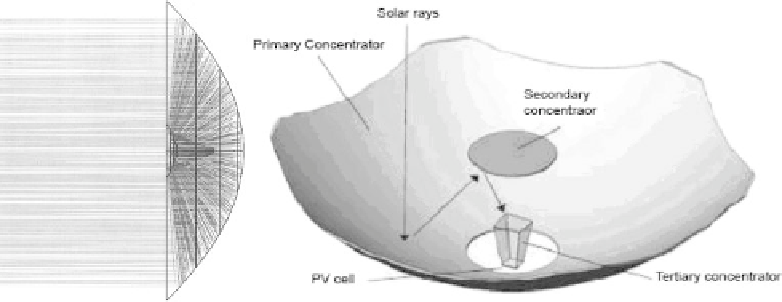Environmental Engineering Reference
In-Depth Information
Figure 17.2.5
Schematic of the Cassegrain concentrator. In the left, 2D ray tracing view and in the right,
3D model of the system (Gordon and Feuermann, 2005). (Picture source: Chemisana,
2011).
for flat roofs) where the system is invisible from the exterior. This group is currently
dominated by point focus Fresnel systems.
There are a number of companies producing high concentration systems, some of
whom are mentioned below.
The Spanish company Sol3g, now absorbed by Abengoa Solar, produced a modular
system with a row of 10 Fresnel lenses per module (solar aperture 1200
120 mm
2
)
which may be custom-designed according to space and consumption requirements
(Chellini et al., 2007). The array of modules is positioned on a high precision tracker
fabricated by Feina Ltd. Green and Gold Energy offers a system called SunCube
TM
which consists of a device of approximately 1 m
2
(1064
×
1064 mm
2
) aperture formed
of 9 Fresnel lenses divided into 3 rows. Each system is coupled to a small two-axis
tracker (Green and Goldenergy, 2011). Emcore commercializes a module formed by 8
Fresnel lenses in two lines of 4 (Emcore Soliant 1000). The dimensions of each module
are 733
×
378 mm
2
(Emcore, 2012). Using similar technologies to those previously
mentioned and employing Fresnel lenses, Whitfield Solar designed the WS-Si24 system.
This achieves a concentration factor of 70X and is therefore a medium concentration
system (Anstey et al., 2007). However, the optical and tracking technology used imply
characteristics of integration that place it within this section.
Using point concentration reflectors, Menova developed PowerSpar in two con-
fingurations: the RFP 20 and the RFP 40 which consist of four RFP 20 units (Menova,
2008), and SVV Technology Innovations a Ring Array Concentrator (RAC), which
emulates a point focus lens using reflectors (Vasylyev and Vasylyev, 2002; 2003).
In addition to the above systems, it is worth mentioning the concentrator based
on Cassegrain Optics (Figure 17.2.5) which has been commercialized by SolFocus
(Gordon and Feuermann, 2005; Winston and Gordon, 2005; Mcdonald and Barnes,
2008) and the Light-guide Solar Optics (LSO) system presented by Morgan Solar Inc.
(Morgansolar, 2012), which is based on optical light guides (Figure 17.2.6). As with
the systems described in the previous paragraph, these can be installed on flat roofs.
Both have a minimal receiver size, encapsulating the PV cells within the concentrator
×

Search WWH ::

Custom Search